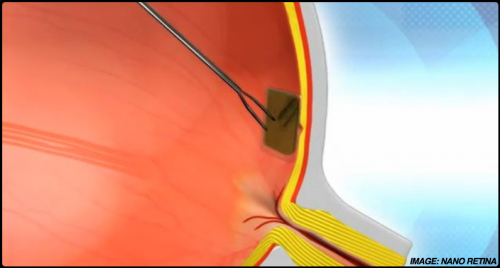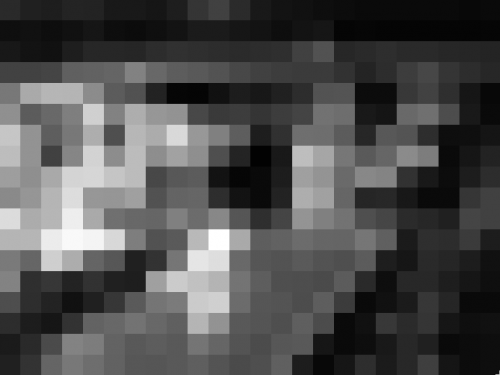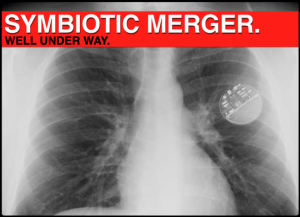Human Eyes. We Can Rebuild Them.
We can make them better. We have the technology. Well… almost. Things are moving fast! The past 10 or so days were stuffed with all kinds of excellent eyeball- and vision-related news of the Was-Blind-But-Now-I-See variety. But like, you know, actually.
Dig the Sample Progression, if You Please:
1. Cure Blindness with Gene Therapy, Stem-Cells, and Vitamins (Oh, very nice!)
2. Researchers Clarify Understanding of Human Vision’s Neural Pathways (Hmm.)
3. Video Software Parses Details Undetectable by the Human Eye (Kinda huge.)
4. Bionic Eye Wires 576 Pixels Directly to the Optic Nerve (That’s paradigmatic.)
Very, very soon, blindness could be effectively cured, and that’s big enough on it’s own, but these developments herald the infancy of something much more profound: the obviation and voluntary replacement of healthy, functional eyes. Hot Damn!
Bionics and Lasers & Stuff!
Okay, so #4 up there, that one’s really the most intriguing. The device, covered nicely here by Kurzweil AI, is being developed by an international consortium called Nano Retina, and they’re going to start sticking their laser-powered electronics into real live humans next year. Here’s what it’s supposed to kinda maybe look like probably:

Put this in there it’s better.
Reinforcing that old stereotype of scientists generally sucking at marketing, they’re calling it the Bio-Retina (Video – PDF). Now, since they’ve effectively created an artificial eyeball of sorts, I guess we can forgive that nobody in the lab said anything about biological retinas coming standard on most vertebrates. What matters here is that this cybernetic hardware/wetware interface is able to make the blind formerly so, and this is only the first generation of the product (and unlikely to be the industry’s only offering).
The company claims implantation will require only 30 minutes under local anesthetic, and with an eyeglass-mounted laser power source, patients will suddenly see 576 grayscale pixels worth of the world (images & gallery below). That doesn’t sound like much, but if your world was dark and devoid of any visual input half an hour ago,
it’s an unprecedented revelation.
And What Could This Become?
The best kind of digital slippery slope, that’s what.
Maybe think about it like this:

And it gets better a whole lot faster now, is the thing.
?s
How quickly will 576 pixels become 10 million?
Can we go all Predator and add currently non-visible spectra?
How about outputting the signal to share with friends… or pay-per-view?
Per article #3 above, could a doctor take a patient’s pulse just by looking at them?
(watch the video in #3 – it’s creepy and awesome)
Oh yeah, and what’s the maximum bandwidth of the optic nerve?
Low-Res vs. No-Res – Easy decision?
There’s something to be said for the community and sense of self one builds around disability, so there will assuredly be a few long-term non-sighted people who find such a procedure distasteful, but they’ll likely be an extreme minority. Seriously, who wouldn’t want to see again, or for the first time?
The Practicalities of the Now:
As you’ll see below, this system isn’t going to make the blind go all Steve Austin. How good will it be? Well, for those of us without the implant, with the exception of a reading test, actual visual acuity is always going to be rather speculative. It’s also difficult to know what the brain is going to do with this simple image. It might actually shock the hell out of everyone but neurologists and start filling in details! We can look at the images below at various “actual” sizes, limited to 24�24 discrete single-tone sections, but for us it’s just a sort of an exercise.
The thing is, if one’s entire field of vision is only 576 grayscale pixels, I guess you’ve gotta, I don’t know, scale to a relative perceptual sweet spot, or some other words that kinda sound like that. Otherwise stated, adjusting distance from sensor to what’s being sensed, virtually or otherwise, is key. Lensing, yo. And anotherwise stated: Focus.
How’s that work?
Okay, the blah blah blah wraps up here.
But take a look at the sample images and the gallery below.
Then imagine you were entirely unable to follow that last order.
Those mere 576 pixels begin to sound and look quite nice.
And remember, this is just the beginning.
IMAGES – LIFE AT 576 PIXELS:
This will vary depending on your current monitor.
As a point of reference here are some actual 24�24-pixel images:
![]()
![]()
![]()
Realistically, the visual information will probably be closer to this:
 or this:
or this:
 or this:
or this:
 or this:
or this:

These above are common sights at 576 grayscale pixels.
(last two images are 24x15px for aspect ratio)
Click any image to see the full-res shots.
GALLERY:
The Intentionally Mundane at 576 Pixels:[slideshow gallery_id=”5″]
For all TRANSHUMANISM TEST PILOTS posts,
click on those words above these words.
___
Anthrobotic is an Amazon.com Associate. Anytime, any product, click through!
![]() Costs the same. Amazon gets your business. Anthrobotic gets a digital high-five. Win³.
Costs the same. Amazon gets your business. Anthrobotic gets a digital high-five. Win³.








I have very very short. Sighted ness . I am very much interested . Pls send more info. Thanks
Hmmm… this is one of those comments where you’re just not sure if it’s a human or not. Assuming it is a bipedal mammal, I refer you back to the piece above – it contains links to all source material, etc. And thanks for reading
…if you’re real.